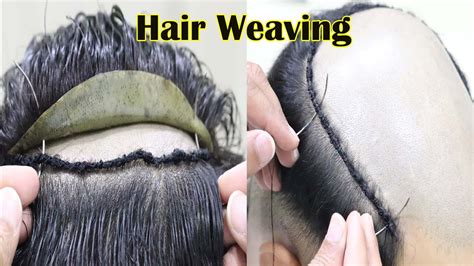Hair loss is an issue that affects millions of people around the world, both men and women. It can be caused by a variety of factors, including genetics, hormonal changes, medical conditions, and certain medications. Thinning hair can be a significant source of stress and anxiety, as it can affect a person’s self-esteem and confidence.

Fortunately, there are a number of hair weaving hair weaving techniques that can be used to add volume and thickness to thinning hair. Hair weaving is a semi-permanent method of hair extension that involves attaching individual strands of human or synthetic hair to the natural hair using a small bead or loop. The hair can be matched to the natural hair color and texture, creating a seamless and natural-looking result.
Hair weaving offers a number of benefits for people with thinning hair, including:
- Increased volume and thickness: Hair weaving can significantly increase the volume and thickness of thinning hair, creating a fuller, more youthful appearance.
- Natural-looking results: Hair weaving can be matched to the natural hair color and texture, creating a seamless and natural-looking result.
- Semi-permanent solution: Hair weaving is a semi-permanent method of hair extension, meaning that it can last for several months with proper care and maintenance.
- Versatile: Hair weaving can be used to create a variety of different hairstyles, from sleek and polished to voluminous and bouncy.
There are a number of different hair weaving techniques that can be used to add volume and thickness to thinning hair. The most common techniques include:
- Micro-link: Micro-link hair weaving involves attaching individual strands of hair to the natural hair using small, copper-plated beads. The beads are crimped down to secure the hair in place.
- Nano-link: Nano-link hair weaving is similar to micro-link, but uses even smaller beads to attach the hair. This results in a more natural and discreet appearance.
- Fusion: Fusion hair weaving involves bonding individual strands of hair to the natural hair using a heated keratin tip. The keratin tip melts and fuses the hair together, creating a strong and durable bond.
- Tape-in: Tape-in hair weaving involves attaching pre-bonded hair extensions to the natural hair using a strong adhesive tape. Tape-in hair weaving is a quick and easy way to add volume and thickness to thinning hair, but it is not as durable as other methods.
The best hair weaving technique for you will depend on a number of factors, including the type of hair you have, the desired results, and your budget. If you have fine or fragile hair, micro-link or nano-link weaving may be a good option. If you have thicker hair, fusion or tape-in weaving may be more suitable.
It is important to consult with a professional hairstylist to determine the best hair weaving technique for you. A hairstylist can assess your hair type and condition and recommend the technique that is most likely to achieve the desired results.
The cost of hair weaving varies depending on the type of technique used, the amount of hair needed, and the experience of the hairstylist. Micro-link and nano-link weaving typically cost more than fusion or tape-in weaving. The cost of hair weaving can range from $500 to $2,000 or more.
Hair weaving requires regular maintenance to keep it looking its best. This includes washing and conditioning the hair regularly, using a wide-toothed comb to detangle the hair, and avoiding heat styling. It is also important to have the hair weaving re-tightened every 6 to 8 weeks to ensure that it remains secure.
Hair weaving is a versatile and effective solution for thinning hair. It can add volume and thickness to thinning hair, creating a fuller, more youthful appearance. Hair weaving is a semi-permanent solution that can last for several months with proper care and maintenance.
